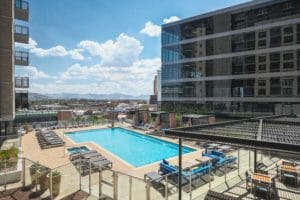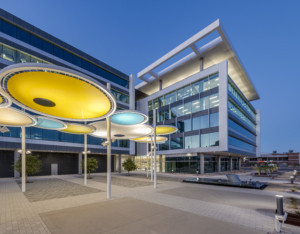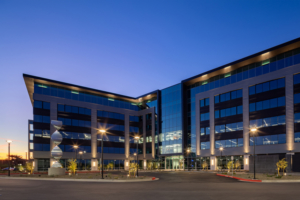Green building is inevitably a smart business solution.
When it comes to the bottom line, companies that want to be in the black — go green. As building owners, developers, brokers and designers, the industry is trying to re-define how they do business to stay in business, and it is vital that these efforts align with the paradigm toward green building.
Existing assets — empty buildings, existing properties with leases expiring, etc. — may be the most marketable commodity right now. Building owners should look at new ways to use this economic downturn as an opportunity, and not a road block. By incorporating four simple measures, owners and developers can reposition their real estate assets to be more marketable — a concept better known as real estate asset positioning (REAP).
GOING GREEN – GREEN BUILDING
Invest in sustainable strategies. A building that can call itself “green” is much more marketable than one that lacks environmentally conscious attributes. Leading organizations are demanding green designs, while employees increasingly view sustainability as a corporate responsibility. In fact, a Harris Poll found that 33 percent of Americans would be more inclined to work for a green company, than one that did not make a conscious effort to promote sustainable practices.
Daylighting, shading, varied glass types and occupancy sensors are just a few strategies that have demonstrated a quantifiable Return On Investment (ROI), and are proven to benefit occupant health and well-being. Furthermore, increased building value and elevated rents often have been cited as benefits of green buildings, according to Turner’s 2008 Green Building Market Barometer. Going “green” is a great way for building owners to leverage their assets for strategic market repositioning.
ENERGY REDUCTION
Incorporate measures to reduce consumption by investing in sustainable strategies that are efficient in their use of water, energy and other resources. Examples include using low-flow plumbing fixtures, high-efficiency lighting and air quality monitoring.
Out of 754 commercial real estate executives surveyed, Turner’s report found:
- 84 percent of respondents cited lower energy costs in green buildings
- 68 percent noted overall operating cost savings
- 72 percent say green creates higher building values
Sundt Construction, currently in the process of realizing a lab building for an Arizona university, conducted energy consumption metrics showing the cost to provide occupancy sensors for a 294,000-square-foot building would be $15,598. The owner’s savings for the first year were estimated at $29,905 — a noticeably fast payback on an initial investment.
Building owners and some tenants also may receive tax deductions of up to $1.80 per square foot if they install energy-efficient interior lighting; upgrade the building envelope; and install heating, cooling, ventilation and/or hot water systems to reduce energy consumption by 50 percent, in comparison to meeting minimum ASHRAE 90.1 requirements.
MARKET DRIVEN
Focus on looks and extras. When it comes to attracting the best tenants in today’s real estate market, there has never been a more prudent time to assess an existing building’s worth.
Upgrading and retrofitting 40-, 20- and even 10–year-old buildings during this economic downturn can result in significant cost savings, as the current market experiences up to a 30 percent drop in construction costs.
New lobbies and entries, updated restrooms and elevators will attract potential tenants and retain existing ones, who may be considering relocation. Providing additional amenities to elevate an existing building to Class A office space provides the competitive edge necessary to exist in the new, highly competitive marketplace.
In addition, envelope and exterior skin upgrades from Low-E insulated glazing units to new, longer lasting and maintenance-free, environmentally friendly materials will enhance the building’s appearance, as well as its internal support systems.
By incorporating aesthetic upgrades and modernizations to reposition assets, a building’s life can be extended well beyond its initial years.
ADAPTIVE REUSE
Innovate. It’s easy to envision an existing historic structure retrofitted into a modern, trendy boutique hotel. However, it takes a creative mind to realize that a brand new, empty, speculative high-rise office building has that same potential.
The real estate is there — it’s a matter of incorporating flexibility into the process of assessing the market’s changing demand. Introducing a new function or use into an existing asset, based on what the market is saying, is a cost-effective way to extend the longevity of a building and exceed the ROI on existing real estate.
What better way to “go green” than to recycle and re-use an existing building?
As asset repositioning — or REAP — continues to catch on, the value of revitalizing existing buildings is becoming paramount to how the economy will affect the design and construction industry in Arizona for the next 10 to 20 years. Understanding the market demand and how it affects an existing asset is the first step. Secondly, developing an analysis of the property may be the most viable way to determine its future potential — whether it makes sense to update, retrofit or green-up, the possibilities are infinite.
This is not a new practice, just a smart one that will provide ongoing opportunity for those willing to take the plunge and invest in what already exists. Let’s REAP the benefits together!
[stextbox id=”grey”]
Martha Abbott is an architectural senior project manager for the Workplace Studio of SmithGroup’s Phoenix office, with 20 years of experience.
[/stextbox]



